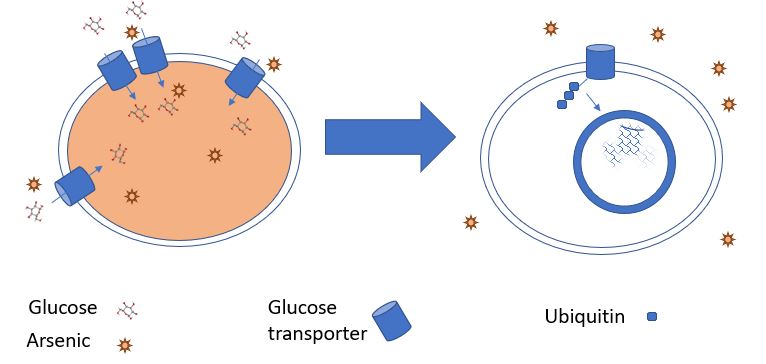Yeast are a genetically tractable model system to study various aspects of cellular physiology or toxicology. In the study by Jochem and colleagues, the researchers investigated a potential mechanism for a connection between arsenic exposure and type 2 diabetes by analyzing the effects of arsenic exposure in yeast. This study is a follow up to a proteomic study performed with yeast to understand how arsenic exposure, which is toxic, alters the proteins in the cells, referred to as the cellular proteome. That initial study identified sugar transporters as some of the proteins that were reduced the most in abundance following yeast exposure to arsenic.
In the current study, the researchers found that genetically engineered yeast lacking all 7 hexose transporters were resistant to arsenic toxicity. Arsenic exposure resulted in degradation of the transporters through a mechanism that required lysosomes (called vacuoles in yeast), which are membrane-bound organelles where degradation occurs, and not proteasomes, which are a large multiprotein molecular machines that degrade proteins. Through genetic approaches, Ubc4 and Rsp5 were identified as the enzymes responsible for tagging the transporters with ubiquitin (a protein that can mark other proteins for degradation). To identify the hexose transporter residues that were modified by ubiquitin, the authors used a targeted proteomics approach that enriched the samples for peptides with lysine-glycine-glycine, indicative of ubiquitin attachment.

Figure 1. Degradation of glucose transporters in yeast exposed to arsenic. Read more
Additional studies showed that the reduction in transporter abundance through ubiquitin-mediated lysosomal targeting represented an adaptive response that enabled the yeast cells to survive in the presence of arsenic (Figure 1). This is consistent with the ability of these transporters to import arsenic. Thus, getting less arsenic into the cells by reducing the amount of the transporters would increase cell survival in the presence of arsenic.
In terms of how this study may relate to humans, epidemiological studies indicate there is a link between arsenic exposure and the development of type 2 diabetes. This study provides a possible mechanism: Degradation of glucose transporters to limit arsenic uptake into cells would also impair glucose uptake, leading to increased glucose in the circulation, insulin resistance, and diabetes.
Highlighted Article
M. Jochem, L. Ende, M. Isasa, J. Ang, H. Schnell, A. Guerra-Morena, Y. Micoogullari, M. Bhanu, S. P. Gygi, J. Hanna, Targeted Degradation of Glucose Transporters Protects Against Arsenic Toxicity. Mol. Cell. Biol. 2019 Mar 18; MCB.00559-18. doi: 10.1128/MCB.00559-18. PubMed
Cite as: N. R. Gough, Yeast Study Links Arsenic to Diabetes through Glucose Transporters. BioSerendipity (15 April 2019)
https://www.bioserendipity.com/yeast-study-links-arsenic-to-diabetes-through-glucose-transporters/.

